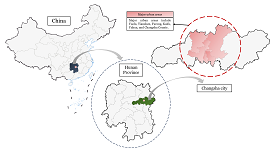
Asia Pacific Academy of Science Pte. Ltd. (APACSCI) specializes in international journal publishing. APACSCI adopts the open access publishing model and provides an important communication bridge for academic groups whose interest fields include engineering, technology, medicine, computer, mathematics, agriculture and forestry, and environment.

As China's pillar industry, the property market has suffered a considerable impact in recent years, with a decline in turnover and many developers at risk of bankruptcy. As one of the most concerned factors for stakeholders, housing prices need to be predicted more objectively and accurately to minimize decision-making errors by developers and consumers. Many prediction models in recent years have been unfriendly to consumers due to technical difficulties, high data demand, and varying factors affecting house prices in different regions. A uniform model across the country cannot capture local differences accurately, so this study compares and analyses the fitting effects of multiple machine learning models using February 2024 new building data in Changsha as an example, aiming to provide consumers with a simple and practical reference for prediction methods. The modeling exploration applies several regression techniques based on machine learning algorithms, such as Stepwise regression, Robust regression, Lasso regression, Ridge regression, Ordinary Least Squares (OLS) regression, Extreme Gradient Boosted regression (XGBoost), and Random Forest (RF) regression. These algorithms are used to construct forecasting models, and the best-performing model is selected by conducting a comparative analysis of the forecasting errors obtained between these models. The research found that machine learning is a practical approach to property price prediction, with least squares regression and Lasso regression providing relatively more convincing results.
Will cultural diversity block the process of urbanization?—Empirical Study from the perspective of dialect
Vol 5, Issue 1, 2024
Download PDF
Abstract
Based on the data samples of 276 cities at prefecture level and above in China from 2000 to 2012, using dialect diversity as a proxy to measure cultural diversity, using random effect model, system generalized moment estimation, two-stage least square method and other methods, this paper conducted an empirical investigation on the impact of cultural diversity on China's urbanization for the first time. It is found that dialect diversity has a significant negative impact on urbanization rate; considering the possibility of missing variables, the influence of dialect diversity on urbanization rate is still significantly negative; after using the historical immigration as the instrumental variable of dialect diversity, this negative influence still exists, but the degree of influence has decreased. Therefore, the cultural variables represented by dialects are an important factor affecting the process of urbanization.
Keywords
References
- Pandey SM. Nature and Determinants of Urbanization in a Developing Economy: The Case of India. Economic Development and Cultural Change. 1977; 25(2): 265–278. doi: 10.1086/450946
- Chang GH, Brada JC. The paradox of China’s growing under-urbanization. Economic Systems. 2006; 30(1): 24–40. doi: 10.1016/j.ecosys.2005.07.002
- Moomaw RL, Shatter AM. Urbanization and Economic Development: A Bias toward Large Cities? Journal of Urban Economics. 1996; 40(1): 13–37. doi: 10.1006/juec.1996.0021
- Zhang T, Li B, Bu Y, Wu C. Manufacturing industry, land cost and China's urban development -- a panel data model of the determinants of China's urbanization. Financial research. 2007; (3): 10–24.
- Wang d, Zhu N. Regional differences in determinants of China's urbanization development. China population, resources and environment. 2007; (1): 66–71.
- Zhang H. Some basic ideas on solving the housing problem of migrant workers. Journal of East China Normal University: Philosophy and Social Sciences Edition. 2016; (6): 141–144.
- Wan G, Zheng S. Hofmann A. Determinants of urbanization level: Transnational regression model and analysis. World economic journal. 2014; (4): 20–35.
- Wang X, Chen Z. Determinants of China's urbanization level: Based on international experience. World economy. 2015; (6): 167–192.
- Liu R, Shi L. Ownership basis of China's urbanization stagnation: theoretical and empirical evidence. Economic research. 2015; (4): 107–121.
- Xu X, Liu Y, Xiao Z. Dialect and economic growth. Journal of economics. 2015; (2): 1–32.
- Gao B, Zhang Z. Cultural Capital: an explanation of the source of economic growth. Journal of Nanjing University: philosophy, humanities and Social Sciences. 2004; (5): 102–112.
- Nanjing Social Sciences. High wave China's economic growth: an analytical framework of cultural change. Nanjing Social Sciences. 2007; (7): 17–25.
- Jiang L. Cultural dimension and spatial economic growth. Economist. 2010; (5): 81–87.
- Zhu K, Li J, Le F. An empirical study on the relationship between urbanization and economic growth in China. Statistical research. 2011; (9): 80–87.
- Liu Y, Xu X, Xiao Z. The inverted U-shaped model of labor flow across dialects. Economic research. 2015; (10): 134–146.
- Fu A. Chinese dialects and national languages. Dialect. 2001; (3): 193–198.
- Zhongzhou journal. Peizeren Population migration in Ming Dynasty and the formation of Northern Henan dialect. Zhongzhou journal. 1988; (4): 102–106.
- Mai Y. On the formation pattern of Chinese dialects from the emergence and development of Cantonese. Dialect. 2009; (3): 219–232.
- Han S. During the northern and Southern Dynasties, the border Haozu of huaihan and Yibei. Beijing: Social Science Literature Press; 2003.
Supporting Agencies
Copyright (c) 2024 shuai Shao, guangqin Li, jianhua Cao

This work is licensed under a Creative Commons Attribution 4.0 International License.

This site is licensed under a Creative Commons Attribution 4.0 International License (CC BY 4.0).

Prof. Mehmet Cetin
Kastamonu University,
Turkey
Polish Scientific Bibliography

